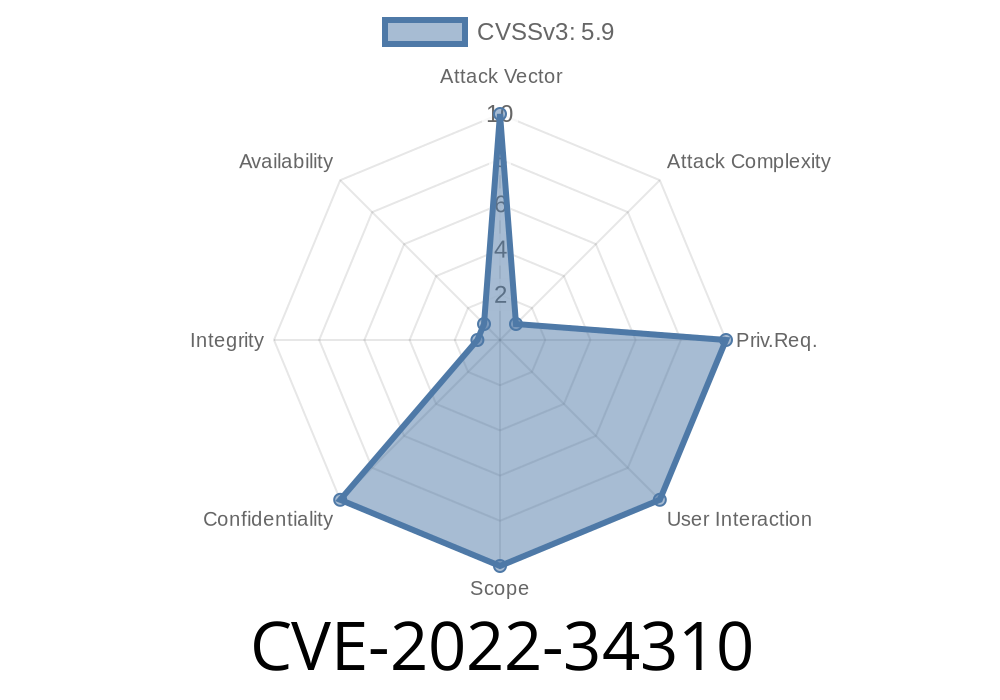The IBM CICS Transaction Server is utilized by many organizations for reliable and secure transaction processing. However, it has been identified that versions 11.1 of CICS TX Standard and Advanced could expose sensitive data due to the use of weaker-than-expected cryptographic algorithms. In this detailed long-read post, we will discuss the CVE-2022-34310 vulnerability, analyze a code snippet, provide references to the original sources, and explore possible exploitation methods and solutions.
Original References & Vulnerability Information
The vulnerability has been assigned the ID CVE-2022-34310 and was first published on 26th August 2022. IBM X-Force has also assigned it an ID: 229441. More information can be found in the following original sources:
- NVD: CVE-2022-34310
- IBM: Security Bulletin
Details of CVE-2022-34310 Vulnerability
The IBM CICS TX Standard and Advanced 11.1 versions are known for their secure and efficient transaction processing capabilities. However, these versions utilize weaker-than-expected cryptographic algorithms, which make them vulnerable to attacks and data decryption. An attacker can exploit this vulnerability to decrypt highly sensitive information, leading to potential security breaches.
IBM specifically identified that the affected cryptographic libraries could expose sensitive data by employing algorithms that are not resistant against modern attacks. The vulnerability has been assigned a CVSS v3 base score of 5.9, which indicates a medium severity rating.
Exploitation and Potential Impact
Due to the use of weaker cryptographic algorithms, threat actors can potentially orchestrate various attacks to exploit this vulnerability. Some examples include:
1. Brute Force Attack: An attacker can perform a brute force attack to systematically decrypt sensitive information by attempting various decryption keys and algorithms.
2. Cryptanalysis: Advanced threat actors could apply cryptanalysis techniques to analyze the underlying encryption mechanisms, resulting in the compromise of encrypted data.
3. Man-in-the-middle Attacks: Exploiting this vulnerability, an attacker could intercept data being transmitted between two systems and leverage weak cryptographic algorithms to decrypt and manipulate the data.
To demonstrate the weakness, consider the following Python code snippet that demonstrates the use of a weak cryptographic algorithm, such as DES:
from Crypto.Cipher import DES
def encrypt(data, key):
des = DES.new(key, DES.MODE_ECB)
return des.encrypt(data)
def decrypt(data, key):
des = DES.new(key, DES.MODE_ECB)
return des.decrypt(data)
key = b'weak_key'
encrypted_data = encrypt(b'sensitive_data', key)
print(f'Encrypted data: {encrypted_data}')
decrypted_data = decrypt(encrypted_data, key)
print(f'Decrypted data: {decrypted_data}')
As you can see, the key used in this example is weak, and the encryption method being employed is the DES algorithm, which is vulnerable to attacks.
Solution and Remediation
IBM has acknowledged this issue and has released an update for IBM CICS TX Standard and Advanced 11.1, which can be downloaded from the IBM Support Website. It is highly recommended that affected users apply the update as soon as possible to mitigate this security risk.
Additionally, organizations should consider the following best practices to improve their overall data security posture:
1. Strong Encryption Practices: Organizations should implement strong encryption mechanisms and avoid utilizing weak and deprecated cryptographic algorithms.
2. Key Management: Organizations should adopt robust key management practices, including securely storing keys and using strong keys for encryption.
3. Regular Security Audits: Conduct regular security audits of the systems and applications to identify and remediate potential vulnerabilities.
Conclusion
In conclusion, this long-read article has provided an in-depth analysis of the CVE-2022-34310 vulnerability associated with the IBM CICS TX Standard and Advanced 11.1 versions. By understanding the weakness, exploitation techniques, and remediation measures, users can take necessary actions to safeguard their sensitive data and maintain their organization's security integrity.
Timeline
Published on: 02/12/2024 18:15:07 UTC
Last modified on: 02/12/2024 20:39:15 UTC
